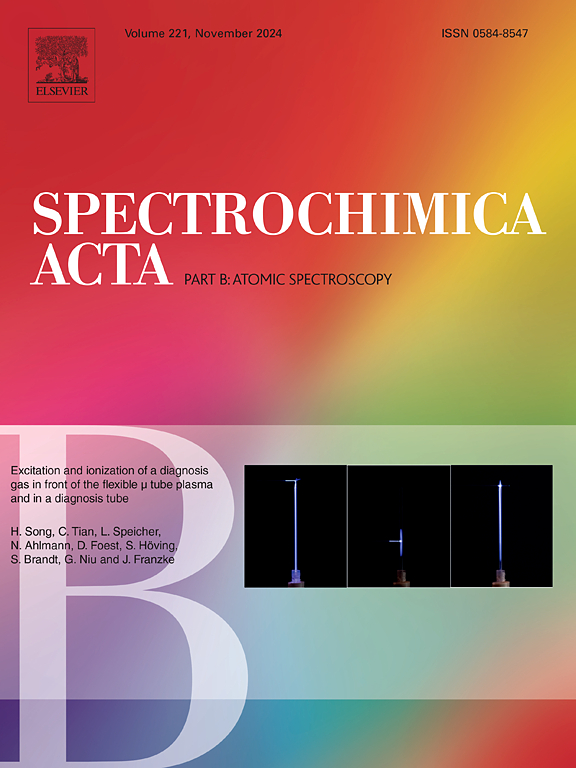原子束波长调制光谱法精确测定铀同位素丰度
IF 3.8
2区 化学
Q1 SPECTROSCOPY
引用次数: 0
摘要
本文介绍了基于原子束波长调制光谱的光学分析系统的设计和演示,该系统用于铀同位素丰度测定。该系统探测了波长为 861.031 nm 的铀 5f36d7s2 (5L6) → 5f26d27s2 (5K5) 转变,该转变被认为是最适合铀同位素分析的转变。在最佳激光波长调制深度小于蚀刻子自由光谱范围(FSR)的条件下,开发了一种新的激光表征策略。该系统具有两项功能,能够更精确地测定原子束的同位素丰度:(1)减少低频附加噪声,特别是黑体辐射引起的噪声;(2)抑制非吸收传输损耗。使用不同同位素组成的铀样品对该系统的性能进行了验证。通过比较直接吸收法和波长调制法对天然铀样品的测量结果,综合吸光度的不确定性降低了 21 倍,数量密度的 1-σ 精确度提高了 6.8 倍。此外,通过比较使用氧化铀样品得出的结果,推断同位素丰度的不确定性降低了 6.1 倍。这些结果表明,1f 归一化 2f 波长调制光谱(WMS-2f/1f)技术能够对原子束进行更高精度的分析。本文章由计算机程序翻译,如有差异,请以英文原文为准。

Accurate determination of uranium isotope abundances by wavelength modulation spectroscopy in atomic beams
The design and demonstration of an optical analysis system based on wavelength modulation spectroscopy in an atomic beam for uranium isotope abundance determinations is presented. This system probes the uranium 5f36d7s2 (5L6) → 5f26d27s2 (5K5) transition at 861.031 nm, which is considered to be the most suitable transition for uranium isotopic analysis. A new laser characterization strategy was developed for the conditions where optimum laser wavelength modulation depth was small compared to the free spectral range (FSR) of etalons. Two capabilities enabled the higher-precision determination of isotope abundances of atomic beams: (1) reduction of low-frequency additive noise, especially the noise caused by black-body radiation and (2) suppression of non-absorption transmission losses. The performance of this system was validated with uranium samples of various isotopic compositions. By comparing the measurements using natural uranium samples between the direct absorption and the wavelength modulation approaches, a 21-fold decrease in uncertainty of the integrated absorbance and a 6.8-fold improvement in the 1-σ precision of the number density were achieved. In addition, by comparing the results using uranium oxide samples, a 6.1-fold decrease in the uncertainty of inferred isotope abundance was obtained. These results demonstrate that the 1f-normalized 2f wavelength modulation spectroscopy (WMS-2f/1f) technique enables higher-precision analysis of atomic beams.
求助全文
通过发布文献求助,成功后即可免费获取论文全文。
去求助
来源期刊
CiteScore
6.10
自引率
12.10%
发文量
173
审稿时长
81 days
期刊介绍:
Spectrochimica Acta Part B: Atomic Spectroscopy, is intended for the rapid publication of both original work and reviews in the following fields:
Atomic Emission (AES), Atomic Absorption (AAS) and Atomic Fluorescence (AFS) spectroscopy;
Mass Spectrometry (MS) for inorganic analysis covering Spark Source (SS-MS), Inductively Coupled Plasma (ICP-MS), Glow Discharge (GD-MS), and Secondary Ion Mass Spectrometry (SIMS).
Laser induced atomic spectroscopy for inorganic analysis, including non-linear optical laser spectroscopy, covering Laser Enhanced Ionization (LEI), Laser Induced Fluorescence (LIF), Resonance Ionization Spectroscopy (RIS) and Resonance Ionization Mass Spectrometry (RIMS); Laser Induced Breakdown Spectroscopy (LIBS); Cavity Ringdown Spectroscopy (CRDS), Laser Ablation Inductively Coupled Plasma Atomic Emission Spectroscopy (LA-ICP-AES) and Laser Ablation Inductively Coupled Plasma Mass Spectrometry (LA-ICP-MS).
X-ray spectrometry, X-ray Optics and Microanalysis, including X-ray fluorescence spectrometry (XRF) and related techniques, in particular Total-reflection X-ray Fluorescence Spectrometry (TXRF), and Synchrotron Radiation-excited Total reflection XRF (SR-TXRF).
Manuscripts dealing with (i) fundamentals, (ii) methodology development, (iii)instrumentation, and (iv) applications, can be submitted for publication.

 求助内容:
求助内容: 应助结果提醒方式:
应助结果提醒方式:


